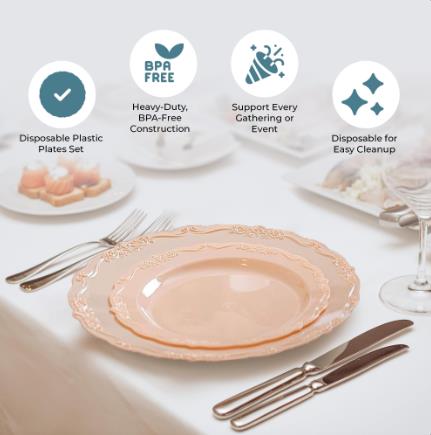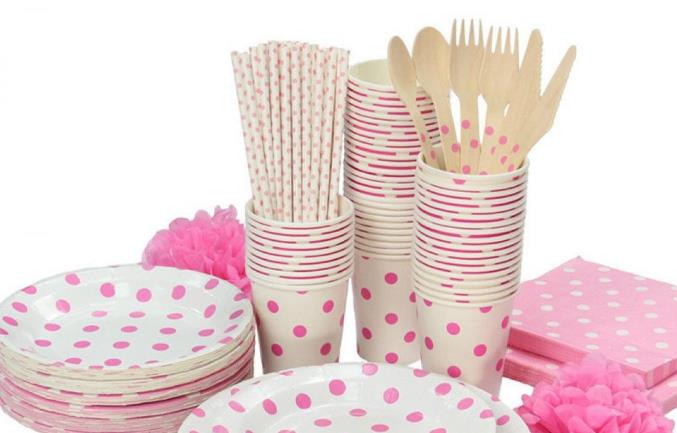
Content Menu
● Introduction
● Materials Needed
● Method 1: Thermoforming Technique
>> Step 1: Prepare the Plastic Sheet
>> Step 2: Create or Choose a Mold
>> Step 3: Preheat the Oven
>> Step 4: Shape the Plate
>> Step 5: Cool and Trim
● Method 2: Injection Molding
>> Step 1: Prepare the Mold
>> Step 2: Set Up the Injection Molding Machine
>> Step 3: Inject the Plastic
>> Step 4: Cool and Eject
● Decorating Your Plates
● Environmental Considerations
● Safety Precautions
● Large-Scale Production
● Alternatives to Plastic
>> Areca Leaf Plates
>> Paper Plates
● Recycling and Disposal
● Conclusion
● FAQs
>> 1. Are homemade plastic plates safe for food use?
>> 2. How long do disposable plastic plates typically last?
>> 3. What are the most eco-friendly alternatives to plastic plates?
>> 4. Can I recycle disposable plastic plates?
>> 5. How can I reduce my use of disposable plates?
● Citations:
Introduction
Disposable plastic plates have become a staple in our modern society, offering convenience for parties, picnics, and everyday use. While these plates are readily available in stores, making your own can be a rewarding and cost-effective project. This article will guide you through the process of creating disposable plastic plates at home, exploring various methods and materials. We'll also discuss the environmental impact and alternatives to consider.

Materials Needed
Before we begin, let's gather the necessary materials:
- Plastic sheets (food-grade)
- Scissors or cutting tools
- Mold or template
- Heat source (oven or heat press)
- Safety equipment (gloves, goggles)
- Decorative elements (optional)
Method 1: Thermoforming Technique
Step 1: Prepare the Plastic Sheet
Cut the plastic sheet into squares slightly larger than your desired plate size. Ensure you're using food-grade plastic to maintain safety standards.
Step 2: Create or Choose a Mold
You can use an existing plate as a mold or create a custom shape using heat-resistant materials. Aluminum molds work well for this purpose.
Step 3: Preheat the Oven
Set your oven to approximately 300°F (150°C). The exact temperature may vary depending on the type of plastic you're using.
Step 4: Shape the Plate
Place the plastic sheet over the mold and carefully put it in the oven. Watch closely as the plastic begins to soften and conform to the mold's shape.
Step 5: Cool and Trim
Once the plastic has taken shape, remove it from the oven and allow it to cool. Trim any excess plastic for a clean edge.
Method 2: Injection Molding
For a more professional approach, you can use an injection molding machine. This method is more suitable for larger-scale production.
Step 1: Prepare the Mold
Design and create a mold for your plate. This can be done using CNC machining or 3D printing.
Step 2: Set Up the Injection Molding Machine
Load the plastic pellets into the machine and set the appropriate temperature and pressure settings.
Step 3: Inject the Plastic
The machine will melt the plastic and inject it into the mold under high pressure.
Step 4: Cool and Eject
Allow the plastic to cool within the mold, then eject the finished plate.
Decorating Your Plates
Once you've created your basic plate, you can add decorative elements:
- Use food-safe paints to add patterns or designs
- Embed glitter or small objects for a unique look
- Apply decals or stickers for themed plates
Environmental Considerations
While making your own disposable plates can be fun, it's important to consider the environmental impact. Plastic waste is a significant global issue. Here are some eco-friendly alternatives to consider:
- Biodegradable materials like cornstarch or sugarcane bagasse
- Reusable plates made from durable, washable materials
- Paper plates for less frequent use

Safety Precautions
When working with plastic and heat, always prioritize safety:
- Wear heat-resistant gloves and safety goggles
- Ensure proper ventilation in your work area
- Keep a fire extinguisher nearby
- Follow all manufacturer instructions for materials and equipment
Large-Scale Production
If you're interested in producing disposable plates on a larger scale, consider investing in professional equipment.
Alternatives to Plastic
For those concerned about the environmental impact of plastic, here are some alternative materials for making disposable plates:
Areca Leaf Plates
Areca leaf plates are an excellent eco-friendly option. They're made from the sheath of areca palm trees and are completely biodegradable.
Paper Plates
While not as durable as plastic, paper plates can be a more environmentally friendly option for light use. Here's how to make them at home:
1. Create a paper mache mixture using flour and water
2. Layer strips of paper over a mold
3. Allow to dry completely
4. Trim edges for a clean finish
Recycling and Disposal
If you do choose to make or use plastic plates, it's crucial to dispose of them properly:
- Check local recycling guidelines for accepted materials
- Clean plates thoroughly before recycling
- Consider upcycling projects for used plates
Conclusion
Making your own disposable plastic plates can be an interesting DIY project or a potential business venture. However, it's essential to weigh the environmental impact against the convenience. As we become more aware of plastic pollution, considering eco-friendly alternatives or reusable options is increasingly important. Whether you choose to make your own plates or opt for sustainable alternatives, the key is to make informed decisions that balance convenience with environmental responsibility.

FAQs
1. Are homemade plastic plates safe for food use?
Homemade plastic plates can be safe for food use if you use food-grade plastic and follow proper sanitation procedures. However, it's crucial to ensure that the plastic you use is certified for food contact and that you maintain clean manufacturing conditions. Always err on the side of caution and consider professional testing if you plan to distribute or sell your homemade plates.
2. How long do disposable plastic plates typically last?
Disposable plastic plates are designed for single-use applications and typically last for the duration of one meal or event. However, depending on the thickness and quality of the plastic, some may be sturdy enough for light washing and reuse. It's important to note that repeated use of disposable plates is not recommended due to potential degradation of the material and hygiene concerns.
3. What are the most eco-friendly alternatives to plastic plates?
The most eco-friendly alternatives to plastic plates include:
- Areca leaf plates: Biodegradable and made from fallen palm leaves
- Bamboo plates: Sustainable and naturally antibacterial
- Sugarcane bagasse plates: Made from agricultural waste and compostable
- Palm leaf plates: Similar to areca, these are biodegradable and stylish
- Wheat straw plates: Durable and made from agricultural byproducts
These options offer varying degrees of biodegradability and sustainability, with minimal environmental impact compared to plastic.
4. Can I recycle disposable plastic plates?
The recyclability of disposable plastic plates depends on the type of plastic used and your local recycling facilities. Many disposable plates are made from polystyrene (PS) or polypropylene (PP), which are not always accepted in curbside recycling programs. Before recycling, check with your local waste management authority for specific guidelines. Clean plates free of food residue have a better chance of being recycled. When in doubt, it's best to dispose of them in the general waste to avoid contaminating recycling streams.
5. How can I reduce my use of disposable plates?
To reduce your use of disposable plates, consider the following strategies:
1. Invest in a set of durable, reusable plates for home and outdoor use
2. Carry your own reusable containers or plates when attending events
3. Encourage the use of real dishes at workplace events or gatherings
4. Choose biodegradable options when disposable plates are necessary
5. Organize plate-sharing or rental services for large community events
By implementing these practices, you can significantly decrease your reliance on disposable plates and reduce waste.
Citations:
[1] https://www.instructables.com/Making-a-Plate-From-Recycled-Plastic/
[2] https://www.youtube.com/watch?v=gNN92_JJs_Q
[3] https://www.youtube.com/watch?v=z8eQ3OpGq0Q
[4] https://www.youtube.com/watch?v=K3CnsUcb0Ew
[5] https://www.instructables.com/DIY-Paper-Plates/
[6] https://www.youtube.com/watch?v=4jhrssvQN_k
[7] https://www.youtube.com/watch?v=Al4id8i-g44
[8] https://www.youtube.com/watch?v=I_r5Wm5cuJU
[9] https://www.istockphoto.com/de/bot-wall?returnUrl=%2Fde%2Fphotos%2Fdisposable-plastic-plates

















